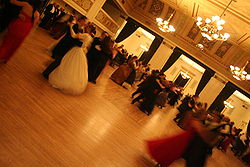- Historical dance
-
Historical dance (or early dance) is a collective term covering a wide variety of dance types from the past as they are danced in the present.
Dances from the early 20th century can be recreated precisely, being within living memory and from the age of film and video recording. However, earlier dance types must be reconstructed from evidence such as surviving notations and instruction manuals.
Historical dances may be danced as performance, for pleasure at themed balls or dance clubs, as historical reenactment, or for musicological or historical research.
The article below mostly discusses Western European social dances. For performance dancing, see the History of dance article.
Contents
Categories of Historical dance
Medieval dance
Very little evidence survives about medieval dance. What we do know comes mostly from paintings and works of literature from this time period. Here are some names of the dances which we know existed during the Middle Ages.
Dance types:
- Carole
- Ductia
- Estampie (Istampitta)
- Saltarello
- Trotto
The farandole is also frequently presented as a medieval dance, based on surviving iconography.
Renaissance dance
The earliest surviving dance manuals come from the Renaissance, including examples by Fabritio Caroso and Thoinot Arbeau. These allow us to reconstruct the dances with a greater degree of certainty. Note the large number of dances with Spanish origin, reflecting the cultural influence of the dominating power of the age.
Dance types:
- Allemande (Almain)
- Basse danse (Bassadance)
- Branle (Bransle)
- Canario
- Coranto
- Dompe
- Galliard
- La volta, variation on the Galliard
- Sarabanda
- Spagnoletta
- Tourdion, a fast Galliard
See also: Shakespearean danceBaroque dance
It was during the baroque era that John Playford published The Dancing Master, which, along with similar publications, provides us with a large repertoire of baroque English country dances.
Apart from country dances, the most well documented dance style of the baroque was that developed at the French court during the 17th century. The term "baroque dance" is often used to refer specifically to this French style, reflecting the dominating power of the era. Dance types include
- Bourrée
- Canary
- Chaconne
- (French) Courante
- Entrée grave
- Forlana
- Gavotte
- Gigue
- Loure
- Menuet (minuet)
- Musette
- Passacaille (passacaglia)
- Passepied
- Rigaudon
- Sarabande
- Tambourin
The French style was also danced in England where they introduced their own dance type:
Dance in the English Regency
We've only just finished the French Revolution and women's fashions enjoy a very brief period of sensibility. Clothing tends to be light and unrestrictive, encouraging dances with lots of skipping and jumping, such as
- English Country Dance
- Regency dance
- Polonaise
- Quadrille
- Scotch Reel
Dance in the mid 19th century
Starting with the great international polka craze of 1844 anyone who was anyone was dancing. Women are in hoop skirts, and turning dances help to keep the skirts out of the way.
- Five Step Waltz
- Polka
- Schottische
- Two Step
- Waltz
Dance in the late 19th century, through 1910 or so
All the same dances that were done in the mid century were still being done in the late century, but by fewer people and with less enthusiasm. Dance masters, in a vain attempt to maintain their place in society and in the economy, invented dances of greater and greater complexity.
The bustle replaces the hoop, which necessitated a few changes in dancing. At the same time, Ragtime music begins its infiltration.
Dance in the Ragtime era
Vernon and Irene Castle bring an air of respectability to couple dancing, and spark what was arguably the largest U.S. dance craze ever. By the end of WWI people eshew these as old fashioned.
Dance in the 1920s
It's the roaring twenties, and kids are spoiled. For the first time, there is a class of children who don't have to immediately go to work to support the family. This is an era of highly energetic dances done by the younger generation.
- Black Bottom
- Charleston
- Foxtrot
- Shag
- Waltz
Dance in the 1930s and 1940s
More than ever before, white society is getting its dances from black society. Swing music and swing dancing are what's happening
- Big Apple (dance)
- Foxtrot
- Swing
- Waltz
- Tap
- Spinning Dance
See also
External links
Categories:
Wikimedia Foundation. 2010.

